DFCC Bank continues its focus on ensuring that its employees are among the most knowledgeable and technically competent in their respective fields of specialisation.
This has become imperative in the face of new technologies and changes in the emerging business environment, as well as evolving customer needs which require entirely new approaches. In turn, staff members have responded with enthusiasm, adaptability and commitment in meeting such challenges. The advanced digital capabilities at DFCC also have played a crucial role in endowing and empowering staff members with new capabilities. The Bank remains committed to upholding the highest standards of ethical practices and the legitimate rights of employees.
Workforce Statistics
During the year under review, taking into consideration the external economic circumstances and resulting impact to business operations, the Bank took a conscious decision to rationalise recruitments, thereby limiting new hires and replacements as much as possible. As such, at the end of 2022, the total work force amounted to 1989, reflecting a decline of 9.2% in comparison to the previous year. In terms of human capital composition, the male:female ratio amounted to 57:43 while approximately 87% were in the permanent cadre. Approximately 63% of employees in the branch network are based outside the Western Province.
Total number of employees
| 2022 | 2021 | 2020 | 2019 | 2018 |
| 1,989 | 2,191 | 2,072 | 2,076 | 1,860 |
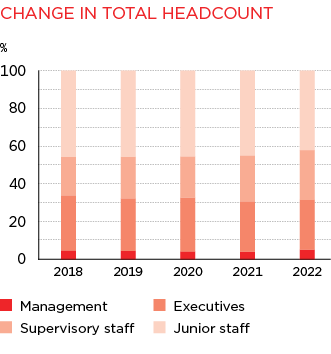
Workforce by employment type/contract and gender
| Grade | Permanent | Contract/Casual/Part time | Total number of employees | ||||||
| Male | Female | Total | Male | Female | Total | Male | Female | Total | |
| Management | 74 | 25 | 99 | 4 | 3 | 7 | 78 | 28 | 106 |
| Executive | 341 | 178 | 519 | 3 | 1 | 4 | 344 | 179 | 523 |
| Supervisory staff | 258 | 263 | 521 | 3 | 0 | 3 | 261 | 263 | 524 |
| Junior staff | 328 | 269 | 597 | 127 | 112 | 239 | 455 | 381 | 836 |
| Total | 1,001 | 735 | 1,736 | 137 | 116 | 253 | 1138 | 851 | 1,989 |


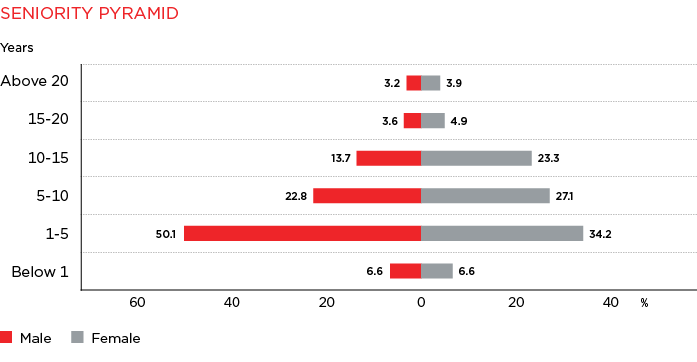
Talent Acquisition
The Bank, in tandem with the banking sector and many other industries, experienced a significant loss of skilled resources during the second half of the year due to migration and overseas job opportunities. While, recruitment for replacements and new positions were done on a very selective basis, many challenges continue to be experienced due to the dearth of relevant skills in the current market.
Responding to the external challenges experienced during the year, ensuring the selection and on boarding of the right talent, possessing the required competencies, and cultural and value “fit” with the Bank, was accorded special focus. During the year under review, DFCC Bank focused on multiple digital platforms, referral schemes, engagements with educational institutions and headhunting in order to attract high calibre talent where needed.
New hires by age group and gender
| Grade | New employees joining in 2022 | ||||||
| Age Group | Gender | ||||||
| Less than 30 years | Between 30-50 years | Above 50 years | Total | Male | Female | Total | |
| Management | 0 | 3 | 3 | 6 | 5 | 1 | 6 |
| Executive | 8 | 42 | 1 | 51 | 40 | 11 | 51 |
| Supervisory Staff | 22 | 13 | 0 | 35 | 18 | 17 | 35 |
| Junior Staff | 179 | 8 | 0 | 187 | 102 | 85 | 187 |
| Total | 209 | 66 | 4 | 279 | 165 | 114 | 279 |
Retention of new hires
| Total New Recruits | Retained | Retention % | |
| Management | 6 | 6 | 100 |
| Executive | 51 | 46 | 90 |
| Supervisor | 35 | 29 | 83 |
| Junior Staff | 187 | 153 | 82 |
| Total | 279 | 234 | 84 |
While the retention rates of new hires are relatively high, it is noted that the bulk of the exits are at very junior levels. The Bank expends considerable effort to ensure new recruits have a positive on boarding experience and assimilate well to the work environment through on boarding training opportunities, availability of buddy programmes etc. During the year, 279 new employees were recruited, of which 67% were in the junior cadre, and approximately 75% of them were under the age of 30 years.
Learning and Development
The Bank’s strategic goals and business plan form the basis of the L&D framework for each year. At the beginning of each year, the training needs of employees are gathered by supervisors following one-on-one discussions with employees. The Training Unit also conducts discussions with supervisors as well as focus group meetings with selected broad staff groups in order to better ascertain the overall business needs and expectations. Based on the feedback acquired through the above mechanisms, annual and monthly training plans are formulated and rolled out.
The Bank continued to provide targeted development opportunities for identified individuals with high potential, including leadership training, job enhancements, special assignments, access to specialised training opportunities, etc. Employees are offered access to training based on needs defined in their individual development plans as well as the competencies required for their job roles. Employees and supervisors also have the option of obtaining additional skills in areas of special interest, which could further propel their ascent through the ranks.
Job rotation of staff across varying functional departments takes into account the future potential of staff and succession planning requirements of the Bank. Transfers are carried out in keeping with the transfer policy of the Bank.
During 2022 the rapidly escalated cost of travel as well as fuel restrictions inhibited in person learning opportunities and interactions. During the fiscal year, approximately 17,000 participants attended 356 programmes, of which 75% were conducted utilising virtual platforms.
The Bank’s eLearning platform, “eAcademy” continues to facilitate online training, including mobile-enabled learning. This has been invaluable in reaching out to regionally dispersed employees as it has provided them with the necessary access and convenience to learn according to their personal schedules. This platform currently provides access to 63 technical and soft skills modules, with the content regularly reviewed and updated and new content added periodically. During the year under review, over 34,000 hours of learning were clocked in the eAcademy.
| Number of Programmes | Training Hours | |
| Online training | 268 | 13,785 |
| Onsite training | 88 | 2,997 |
| E-learning | 63 | 10,503 |


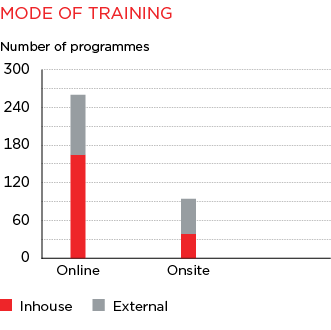
Career Progression Opportunities
Offering transparent and viable paths for career development and advancement for our employees continued to be a key priority. While employees continued to be afforded access to training and leadership development programmes, they were also continued to be advised and mentored on available career advancement opportunities and processes, and the importance of taking control of their careers while taking advantage of the personal development opportunities made available to them. Additionally, during the year specialised fast-tracked skilling and competency enhancement programmes are implemented for identified employees displaying exceptional potential. In 2022 two special programmes were launched targeting leadership development of female employees, in line with the Bank’s priority of enhancing female participation in leadership roles. Opportunities were also provided to high potential staff to participate in special assignments to enhance exposure and visibility through participation in the DFCC Agile project, War Rooms, special committees etc.
Despite the challenges experienced during the year, DFCC continued to prioritise on career enhancement. During the year 342 employees received job upgrades subsequent to a transparent evaluation process and amounted to over 16% of the overall cadre.
Workplace Culture and Engagement
The Bank continued to prioritise on employee engagement and ensuring a transparent and inclusive work culture, as part of our human capital strategy. The Bank’s values form the bedrock of our workplace culture and employment practices. During the year under review the Bank’s value framework was revisited and two new values namely Diversity, Equity and Inclusion (DE&I)and Stewardship were introduced.
A robust grievance management framework is in place with multiple avenues for grievance redressal. For example, the Grievance Committee, a cross functional committee with regional representation is available to employees to surface concerns. The Reachout Committee, an all female team, is exclusively available to our female employees, to surface any personal or work related concerns they may have. In addition, regular “Open Days” are held throughout the year while an “Open Door Policy” is actively practiced by the CEO and corporate management to ensure all staff have direct access when needed. The Grievance Policy, which is easily available to all employees via the intranet; WeConnect, provides a transparent and formal framework for employees to surface concerns. Additionally, heads of departments are encouraged to conduct regular skip level meetings and other interactions in order to further their accessibility and engagement with their staff. The Whistleblowing Policy actively encourage employees to surface illegal or unethical practices and policy violations. Such matters surfaced are taken very seriously by the management with active investigations launched and disciplinary action taken where warranted. The availability of such multiple mechanisms for grievance escalation are intended to provide comfort and access to all employees, irrespective of their grades and geographical locations of work.
Over the years we have also prioritised on new and improved ways of internal communication. The external circumstances encountered during the last couple of years, initially the pandemic and thereafter the fuel crisis, compelled employees to work from home or alternate locations resulting in significant changes to work processes and practices and communication infrastructure. Digital technologies are extensively utilised in conducting meetings, training, interviews and other necessary discussions. The “Listening Wall”, a digital platform introduced a few years ago, is a tool that is extensively utilised by our employees to surface ideas, suggestions and grievances. The Bank’s intranet; WeConnect, is also actively used by employees to update themselves on policies and processes, training offerings, vacancies, events etc. In addition, regular EDM campaigns conveying bank values, DE&I, workplace behaviour, HR policies, etc, were conducted to improve “top of the mind” awareness.
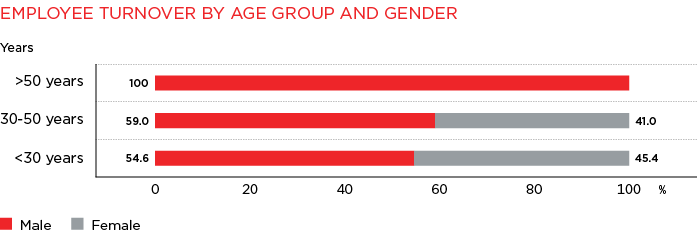
Promoting Diversity, Equity and Inclusion
Over the years, DFCC Bank has continued to actively advocate and promote DE&I in the workplace. Our policies, processes and practices are transparent and equitably applied to all stakeholders, irrespective of gender, race, religion, sexual orientation, economic status or any other social construct.
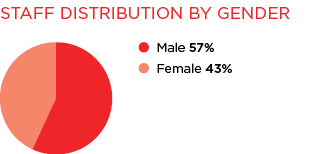
Gender parity continues to be an area of focus. The sustainability strategy of the Bank specifies goals and timelines for improved female participation in leadership roles. The leadership programme for identified high potential female staff continued to be implemented. A new programme targetting improved female representation in Branch Manager (BM) roles was launched in mid 2022. Under this programme, identified participants have been taken through a series of development and empowerment sessions to equip them with the necessary technical and soft skills to assume leadership positions as BMs when opportunities arise. Appreciating the many roles that women are expected to play in society, convenient potential locations have been identified for each of the staff undergoing this programme, subsequent to one-on-one discussions.
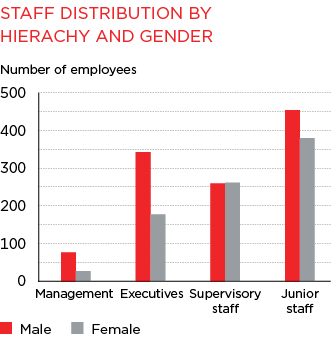
During the year, we continued to accommodate increased staff conveniences through the introduction of flexi hour schemes, provision of special leave/WFH options to female staff during the course of their pregnancy if warranted, provision of adoption leave, special consideration for IVF treatment, etc.
The Bank is an equal opportunity employer, actively encouraging all prospective candidates to apply for vacant positions, with selection solely based on competencies, experience and job fit.
Promotions, transfers, performance evaluations and other HR processes are transparently and equitably implemented with primary consideration being business needs and competencies. Remuneration is based on a structured framework with no bias whatsoever. The table below clearly illustrates pay parity maintained at the Bank.
Ratio of salary of men to women by employee category
| Grade | Number of employees | Basic salary ratio, Male/Female | ||
| Male | Female | Total | ||
| Management | 78 | 28 | 106 | 51:49 |
| Executive | 344 | 179 | 523 | 51:49 |
| Supervisory staff | 261 | 263 | 524 | 50:50 |
| Junior staff | 455 | 381 | 836 | 51:49 |
| Total | 1,138 | 851 | 1,989 | 51:49 |
Gender Parity

In 2022 a special initiative to promote allyship, networking and mentoring was launched targeting women employees in the branch network. Volunteers from each region organised cluster meetings and engaged with female employees in their respective region. These engagements focused on aspects such as work life balance, confidence building, grooming, living the values, dealing with bullying and harassment, importance of empowering and developing other women etc. This initiative covered over 90% of women staff in the branch network and was very positively received.
In keeping with the Bank’s stance on inclusivity and in line with our sustainability goals, providing opportunities for persons with disabilities continued to be an area of priority. In recent months several opportunities were provided and we are currently working on an accessibility audit and strategies for provision of reasonable accommodation to enable more sustainable and meaningful career opportunities for such persons.
Safety and Wellbeing
Occupational Health and Safety (OHS)
The Bank has in place a clearly defined OHS policy which mandates general workplace safety measures that need to be adhered to. An e-Learning module on Occupational Health and Safety is available on the e-academy platform. Information and educational material is also shared among employees with regard to healthy diet and lifestyle, health and safety needs, in addition to providing amenities required for keeping health hazards to the bare minimum. While social distancing and adherence to Covid-related health protocols have been somewhat relaxed, the Bank has continued to encourage employee vaccination. Work-from-Home (WFH) arrangements have now been minimised and most employees have returned to their regular workplaces. However, many flexibilities have been made available to employees based on individual needs. The introduction of a flexi hour mechanism has also boosted convenience and enabled employees to better balance their work responsibilities with personal priorities.
Wellness
Promoting health and wellness continued to be a priority especially considering the unprecedented economic and daily living challenges we encountered as a nation during 2022. The Bank’s wellness committee, OMMM, and HRD organised many initiatives to promote well being, some of which included:
- Monthly fellowship cycling events
- Mental wellness and stress management programmes
- Physical fitness programmes
- Events to engage staff families
- Breast cancer awareness initiative
- Monthly wellness calendar targeting varied topics
- Availability of yoga, zumba and various dance classes
- Provision of subsidised gym and social club memberships
- Provision of financial assistance for purchase of bicycles and related equipment
- Active encouragement of the adoption of cycling as a lifestyle
Providing Relief to Staff
We were very cognisant of the impact of the severe economic and political upheaval experienced in 2022 on our employees, many of whom encountered a significant deterioration in their living condition. Towards easing their burden some of the following measures were adopted:
- Review and revision of remuneration, benefits and incentive structures where possible
- Special relief to junior staff
- Availability of WFH opportunities and special work arrangements to ease transportation constraints
- Actively promoting and enabling cycling as a healthy, viable and cost-effective mode of transport
- Launch of “Rise and Shine” programme focusing on encouraging employees to manage change through programmes focusing on money management, family matters, home gardening etc.
- Initiatives by the OMMM Committee to promote wellness and mental resilience
Benefits
Benefits and emoluments provided to employees are reviewed periodically and revised where warranted in line with industry offerings as well as affordability considerations. The table below illustrates the benefits available to employees of the Bank.
Benefits provided to full time employees which are not provided to contract, temporary or part time employees
|
Employment Type |
Housing Loan | Vehicle Loan* | Exam Loan* | Professional Subscription* | Social Club Gymnasium* |
Miscellaneous/ Staff Loan |
Festival Advance** |
MBA Loan |
Holiday Grant*** |
| Permanent |
|
|
|
|
|
|
|
|
|
| Contract | x | x | x | x | x | x | x | x | x |
* Executive Trainees and Management trainees on Fixed term contracts will also be provided
** Only for non executive staff
*** Based on the offer of employment, may also be provided to contract staff
